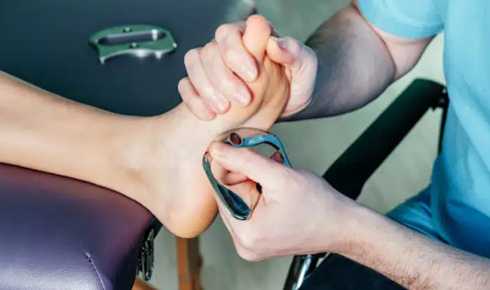
A patient may think the hard part is over once the pain fades, but plantar fasciitis has a reputation for returning if the feet aren’t cared for consistently. Experienced plantar fasciitis doctors know that recovery is only half the journey—what comes next is keeping that progress intact. Their strategies combine practical routines, supportive gear, and mindful activity patterns designed to protect the plantar fascia for the long term.
Structured Stretching Routines to Maintain Plantar Flexibility
Plantar fasciitis specialists often emphasize that daily stretching is non-negotiable for lasting relief. A well-structured routine targets not just the plantar fascia but also the Achilles tendon and calf muscles, as these areas all play a role in foot mechanics. Morning stretches before taking the first steps out of bed can prevent that sharp “first step” pain from returning. Midday and post-activity stretches help maintain tissue elasticity and reduce strain buildup.
Over time, consistent stretching supports better foot alignment and shock absorption. Patients who keep up with these routines are less likely to experience micro-tears or inflammation flare-ups. A plantar fasciitis doctor may customize stretches based on foot shape, gait, and previous injury history, ensuring each movement works toward maintaining optimal flexibility and function.
Supportive Footwear Rotation to Reduce Repetitive Strain
Wearing the same shoes every day can trap the foot in repetitive stress patterns. Specialists often recommend rotating between different pairs of supportive footwear to vary the pressure points and encourage balanced muscle use. The key is to choose shoes with proper arch support, cushioned soles, and a stable heel counter—qualities that reduce the load on the plantar fascia.
This footwear rotation is especially effective for those who spend long hours standing or walking. Alternating shoes also allows the cushioning materials to recover between wears, which maintains their shock-absorbing properties longer. A plantar fasciitis specialist may even advise keeping a set of indoor-only supportive shoes for use at home to further reduce strain from hard flooring.
Gradual Mileage Increases for Runners Returning to Training
For runners, the urge to resume pre-injury mileage too quickly can undo months of recovery. Plantar fasciitis doctors recommend a gradual return—often starting with short, low-intensity runs and slowly increasing distance over weeks. This pacing gives the plantar fascia time to adapt to impact forces again without becoming overloaded.
Pairing shorter runs with walk intervals can also help the foot readjust. Monitoring for early warning signs like heel tightness or mild arch discomfort is essential. By progressing in controlled increments, runners reduce the risk of micro-trauma that could re-ignite inflammation. This approach allows them to regain endurance without sacrificing the stability they worked hard to rebuild.
Daily Calf Strengthening to Stabilize the Heel and Arch
Strong calves play a surprisingly important role in plantar fascia health. A plantar fasciitis specialist will often prescribe exercises like calf raises, toe walks, and resistance band work to build strength in both the gastrocnemius and soleus muscles. This stability helps control the way the heel strikes the ground and how weight is transferred through the arch.
Strengthened calves also improve push-off power during walking or running, which can reduce overcompensation patterns that strain the plantar fascia. Performing these exercises daily—sometimes multiple times in small sets—keeps the lower leg muscles engaged and supportive. Over time, this stability creates a protective effect that makes relapse far less likely.
Low Impact Cross-training to Prevent Overloading the Plantar Fascia
A variety of low-impact activities can keep cardiovascular fitness high while sparing the plantar fascia from repetitive pounding. Swimming, cycling, and elliptical training are common favorites recommended by plantar fasciitis doctors. These activities allow the body to maintain conditioning without the constant stress of high-impact movements.
Mixing cross-training into the weekly routine not only prevents overload but also engages different muscle groups. This balanced approach reduces the risk of muscle imbalances that could affect foot mechanics. A plantar fasciitis specialist might help create a schedule that blends low-impact training with moderate, carefully monitored higher-impact sessions to keep both fitness and foot health on track.
Ongoing Ice and Massage Therapy to Control Minor Flare-ups
Even after recovery, occasional mild soreness can appear—especially after unusually active days. Plantar fasciitis doctors often recommend keeping ice packs or frozen water bottles handy for quick application. Rolling the foot over a cold surface helps reduce inflammation before it becomes more serious. Massage therapy, whether professional or self-applied, can also keep the fascia supple and prevent tight spots from forming.
Incorporating these treatments into a weekly routine works as both prevention and early intervention. A plantar fasciitis specialist might suggest combining ice with gentle stretching after physical activity for maximum benefit. By addressing small irritations early, patients can avoid the setbacks that come with ignoring minor discomfort.
Scheduled Rest Days to Allow Tissue Recovery and Adaptation
One of the most overlooked strategies is purposeful rest. Recovery time is when the plantar fascia repairs micro-damage and adapts to new activity levels. Plantar fasciitis doctors often schedule complete rest days, especially after high-impact workouts or extended periods on the feet. These pauses allow inflammation to subside and tissue to strengthen.
Rest days don’t mean total inactivity—they can include light mobility work, upper body exercise, or non-weight-bearing activities. A plantar fasciitis specialist will tailor the frequency of rest days to the individual’s activity demands and healing progress. By making recovery a consistent part of the plan, patients build resilience into their daily routine and give their feet the chance to stay pain-free over the long term.








